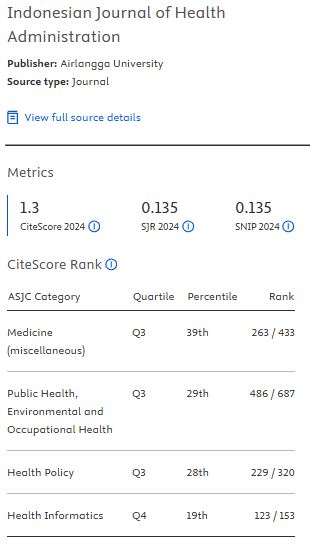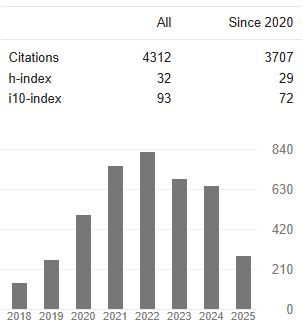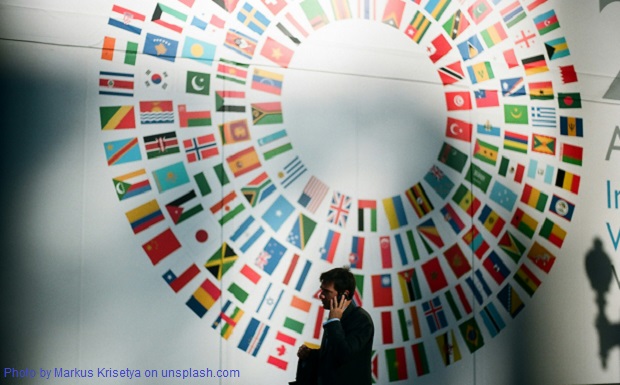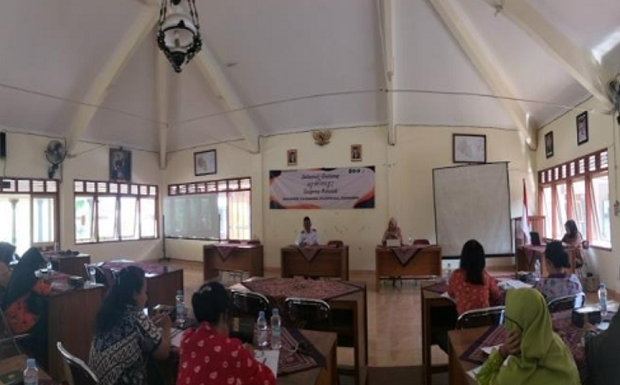SPATIAL ANALYSIS FOR MICROPLANNING TO ADDRESS IMMUNIZATION INEQUALITIES IN INDONESIA
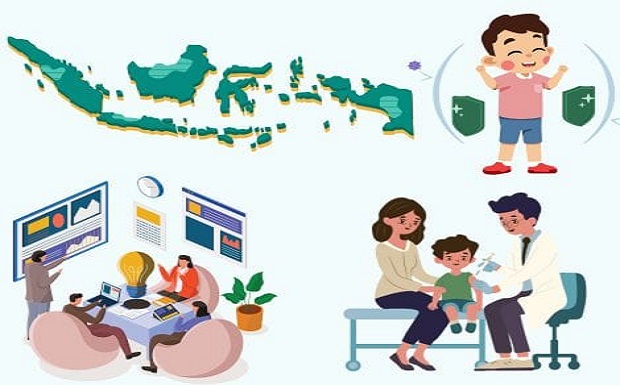
Downloads
Background: To achieve high and equitable immunization coverage, it is important to understand the access and utilization barriers, as well as the influencing determinants among population groups.
Aims: This study aims to identify high-risk regencies and explore the application of spatial analysis to support microplanning in immunization programs.
Methods: This study employed an implementation research design conducted in Aceh Province, Indonesia. Secondary datasets on immunization coverage, health human resources, facilities, and socio-economic parameters were analyzed. Focus group discussions (FGDs) and training sessions were conducted with health workers.
Results: The average coverage of universal child immunization (UCI) across villages was 24.18%, while complete basic immunization (CBI) reached 55.85%. In general, regencies with low UCI and CBI often had limited human resources, inadequate health facilities, and a high proportion of high-risk populations. This study identified hot spots and cold spots in the study area. Additionally, participants reported that mapping using the application was easier and beneficial for supporting the preparation of immunization micro-planning.
Conclusion: Spatial analysis can help address inequalities in immunization services and support resources during immunization. Qualitative approaches provided a deeper understanding of undocumented information. The use of mapping applications facilitated more effective microplanning in immunization programs.
Keywords: Child mortality, health risk, immunization, microplanning, vaccine.
Abdisa, A. B. et al. (2022) ‘Health workers’ use of routine health information and related factors at public health institutions in Illubabor Zone, Western Ethiopia’, BMC Medical Informatics and Decision Making, 22(1), p. 140. doi: 10.1186/s12911-022-01881-y.
Aceh, B. P. (2020) Provinsi Aceh dalam angka. Available at: http://library1.nida.ac.th/termpaper6/sd/2554/19755.pdf.
Aceh, D. K. (2020) Profil kesehatan aceh 2019. Available at: https://scholar.google.com/scholar?hl=id&as_sdt=0%2C5&q=profil+kesehatan+aceh+2019&btnG= (Accessed: 21 December 2020).
Akinyemi, Y. C. (2020) ‘Geospatial Analysis of Vaccination Coverage and Predictors of Non- and Under-Vaccination of Children Aged 12–23 Months in Nigeria’, Papers in Applied Geography. Routledge, pp. 1–33. doi: 10.1080/23754931.2020.1809009.
Ali, D. et al. (2020) ‘A cost-effectiveness analysis of traditional and geographic information system-supported microplanning approaches for routine immunization program management in northern Nigeria’, Vaccine. Elsevier, 38(6), pp. 1408–1415. doi: 10.1016/J.VACCINE.2019.12.002.
Allan, S., Adetifa, I. M. O. and Abbas, K. (2021) ‘Inequities in childhood immunisation coverage associated with socioeconomic, geographic, maternal, child, and place of birth characteristics in Kenya’, BMC Infectious Diseases, 21(1), p. 553. doi: 10.1186/s12879-021-06271-9.
Alsuwaidi, A. R. et al. (2023) ‘Vaccine hesitancy within the Muslim community: Islamic faith and public health perspectives’, Human Vaccines & Immunotherapeutics. Taylor & Francis, 19(1), p. 2190716. doi: 10.1080/21645515.2023.2190716.
Andika, F., Rayyanis, N. and Suanda, J. (2020) ‘Analysis of Measles and Rubella vaccination determinants in toddlers at Kopelma Darussalam health center’, in AIP Conference Proceedings. AIP Publishing LLC, p. 20047.
BPS (2020) Statistik Indonesia 2020. Available at: https://www.bps.go.id/publication/download.html?nrbvfeve=ZTkwMTFiMzE1NWQ0NWQ3MDgyM2MxNDFm&xzmn=aHR0cHM6Ly93d3cuYnBzLmdvLmlkL3B1YmxpY2F0aW9uLzIwMjAvMDQvMjkvZTkwMTFiMzE1NWQ0NWQ3MDgyM2MxNDFmL3N0YXRpc3Rpay1pbmRvbmVzaWEtMjAyMC5odG1s&twoadfnoarfeauf=MjAyMS0wNC0 (Accessed: 16 April 2021).
Bullen, M., Heriot, G. S. and Jamrozik, E. (2023) ‘Herd immunity, vaccination and moral obligation.’, Journal of medical ethics. England, 49(9), pp. 636–641. doi: 10.1136/jme-2022-108485.
Dimitrova, A. et al. (2023) ‘Essential childhood immunization in 43 low- and middle-income countries: Analysis of spatial trends and socioeconomic inequalities in vaccine coverage’, PLOS Medicine. Public Library of Science, 20(1), p. e1004166. Available at: https://doi.org/10.1371/journal.pmed.1004166.
Directorate of Health Worker Planning Indonesia (2022) Target Rasio Tenaga Kesehatan. Available at: https://pusatkrisis.kemkes.go.id/__pub/files71827Salinan_Dokumen_Target_Rasio_Tenaga_Kesehatan.pdf.
Dougherty, L. et al. (2019) ‘From paper maps to digital maps: enhancing routine immunisation microplanning in Northern Nigeria’, BMJ Global Health, 4(Suppl 5), p. e001606. doi: 10.1136/bmjgh-2019-001606.
Harapan, H. et al. (2020) ‘Religion and Measles Vaccination in Indonesia, 1991–2017’, American Journal of Preventive Medicine. doi: https://doi.org/10.1016/j.amepre.2020.07.029.
Jinarong, T. et al. (2023) ‘Muslim parents’ beliefs and factors influencing complete immunization of children aged 0–5 years in a Thai rural community: a qualitative study’, BMC Public Health, 23(1), p. 1348. doi: 10.1186/s12889-023-15273-y.
Johns, N. E. et al. (2022) ‘Association between childhood immunisation coverage and proximity to health facilities in rural settings: a cross-sectional analysis of Service Provision Assessment 2013–2014 facility data and Demographic and Health Survey 2015–2016 individual data in Mal’, BMJ Open, 12(7), p. e061346. doi: 10.1136/bmjopen-2022-061346.
Melaku, M. S., Nigatu, A. M. and Mewosha, W. Z. (2020) ‘Spatial distribution of incomplete immunization among under-five children in Ethiopia: Evidence from 2005, 2011, and 2016 Ethiopian Demographic and health survey data’, BMC Public Health. BioMed Central Ltd, 20(1). doi: 10.1186/s12889-020-09461-3.
Ministry of Health Indonesia (2020a) Buletin Surveilans & Imunisasi. Available at: https://www.who.int/docs/default-source/searo/indonesia/sit-rep/epi-vpd-bulletin-ed1.pdf?sfvrsn=ae70706f_2 (Accessed: 4 January 2023).
Ministry of Health Indonesia (2020b) Profil Kesehatan Indonesia Tahun 2019. Available at: https://www.kemkes.go.id/folder/view/01/structure-publikasi-pusdatin-profil-kesehatan.html (Accessed: 17 February 2021).
Ministry of Health Indonesia (2022) Menkes Optimis Target 95% Anak di Provinsi Aceh Diimunisasi Polio Tercapai – Sehat Negeriku. Available at: https://sehatnegeriku.kemkes.go.id/baca/umum/20221205/1941945/menkes-optimis-target-95-anak-di-provinsi-aceh-diimunisasi-polio-tercapai/ (Accessed: 4 January 2023).
Ministry of Health Indonesia (2023) ‘Laporan Survei Kesehatan Indonesia (SKI) 2023’. Available at: https://layanandata.kemkes.go.id/katalog-data/ski/ketersediaan-data/ski-2023.
Muharram, F. R. et al. (2024) ‘Adequacy and Distribution of the Health Workforce in Indonesia’, WHO South-East Asia Journal of Public Health, 13(2). Available at: https://journals.lww.com/wsep/fulltext/2024/13020/adequacy_and_distribution_of_the_health_workforce.2.aspx.
Mulyanto, J., Kunst, A. E. and Kringos, D. S. (2019) ‘Geographical inequalities in healthcare utilisation and the contribution of compositional factors: A multilevel analysis of 497 districts in Indonesia’, Health & Place. Elsevier Ltd, 60(August), p. 102236. doi: https://doi.org/10.1016/j.healthplace.2019.102236.
Mulyanto, J., Kunst, A. E. and Kringos, D. S. (2020) ‘The contribution of service density and proximity to geographical inequalities in health care utilisation in Indonesia: A nation-wide multilevel analysis’, Journal of global health. International Society of Global Health, 10(2), p. 20428. doi: 10.7189/jogh.10.020428.
Ogero, M. et al. (2022) ‘Pentavalent vaccination in Kenya: coverage and geographical accessibility to health facilities using data from a community demographic and health surveillance system in Kilifi County’, BMC Public Health, 22(1), p. 826. doi: 10.1186/s12889-022-12570-w.
Oteri, J. et al. (2021) ‘Application of the Geographic Information System (GIS) in immunisation service delivery; its use in the 2017/2018 measles vaccination campaign in Nigeria’, Vaccine, 39, pp. C29–C37. doi: https://doi.org/10.1016/j.vaccine.2021.01.021.
Peters, D. H. et al. (2013) ‘Implementation research: what it is and how to do it.’, BMJ (Clinical research ed.). England, 347, p. f6753. doi: 10.1136/bmj.f6753.
Rakmawati, T., Hinchcliff, R. and Pardosi, J. F. (2019) ‘District‐level impacts of health system decentralization in Indonesia: A systematic review’, The International journal of health planning and management. Wiley Online Library, 34(2), pp. e1026–e1053.
Rasmussen, A. L. (2020) ‘Vaccination Is the Only Acceptable Path to Herd Immunity.’, Med (New York, N.Y.). United States, 1(1), pp. 21–23. doi: 10.1016/j.medj.2020.12.004.
Schaller, J., Schulkind, L. and Shapiro, T. (2019) ‘Disease outbreaks, healthcare utilization, and on-time immunization in the first year of life’, Journal of Health Economics. North-Holland, 67, p. 102212. doi: 10.1016/J.JHEALECO.2019.05.009.
Singh, S. K. and Vishwakarma, D. (2021) ‘Spatial heterogeneity in the coverage of full immunization among children in India: Exploring the contribution of immunization card’, Children and Youth Services Review, 121, p. 105701. doi: https://doi.org/10.1016/j.childyouth.2020.105701.
Tesfa, G. A. et al. (2022) ‘Spatial distribution and associated factors of measles vaccination among children aged 12–23 months in Ethiopia. A spatial and multilevel analysis’, Human Vaccines & Immunotherapeutics. Taylor & Francis, 18(1), p. 2035558. doi: 10.1080/21645515.2022.2035558.
Umer, M. F. et al. (2020) ‘Spatiotemporal clustering analysis of Expanded Program on Immunization (EPI) vaccination coverage in Pakistan’, Scientific Reports, 10(1), p. 10980. doi: 10.1038/s41598-020-67839-0.
WHO (2009) Microplanning for immunization service delivery using the Reaching Every District (RED) strategy. Available at: https://www.who.int/publications/i/item/microplanning-for-immunization-service-delivery-using-the-reaching-every-district-(-red)-strategy (Accessed: 11 January 2023).
WHO (2020) Immunization coverage. Available at: https://www.who.int/en/news-room/fact-sheets/detail/immunization-coverage (Accessed: 22 December 2020).
WHO (2025) Vaccines and immunization. Available at: https://www.who.int/health-topics/vaccines-and-immunization#tab=tab_1 (Accessed: 16 April 2025).
Copyright (c) 2025 Erni Astutik, Arief Hargono, Kurnia Dwi Artanti, Atik Choirul Hidajah, Zida Husnina, Siti Shofiya Novita Sari, R. Vensya Sitohang, Asik Surya, Ratna Budi Hapsari, Marta Feletto

This work is licensed under a Creative Commons Attribution-ShareAlike 4.0 International License.
1. As an author you (or your employer or institution) may do the following:
- make copies (print or electronic) of the article for your own personal use, including for your own classroom teaching use;
- make copies and distribute such copies (including through e-mail) of the article to research colleagues, for the personal use by such colleagues (but not commercially or systematically, e.g. via an e-mail list or list server);
- present the article at a meeting or conference and to distribute copies of the article to the delegates attending such meeting;
- for your employer, if the article is a ‘work for hire', made within the scope of your employment, your employer may use all or part of the information in the article for other intra-company use (e.g. training);
- retain patent and trademark rights and rights to any process, procedure, or article of manufacture described in the article;
- include the article in full or in part in a thesis or dissertation (provided that this is not to be published commercially);
- use the article or any part thereof in a printed compilation of your works, such as collected writings or lecture notes (subsequent to publication of the article in the journal); and prepare other derivative works, to extend the article into book-length form, or to otherwise re-use portions or excerpts in other works, with full acknowledgement of its original publication in the journal;
- may reproduce or authorize others to reproduce the article, material extracted from the article, or derivative works for the author's personal use or for company use, provided that the source and the copyright notice are indicated.
All copies, print or electronic, or other use of the paper or article must include the appropriate bibliographic citation for the article's publication in the journal.
2. Requests from third parties
Although authors are permitted to re-use all or portions of the article in other works, this does not include granting third-party requests for reprinting, republishing, or other types of re-use.
3. Author Online Use
- Personal Servers. Authors and/or their employers shall have the right to post the accepted version of articles pre-print version of the article, or revised personal version of the final text of the article (to reflect changes made in the peer review and editing process) on their own personal servers or the servers of their institutions or employers without permission from JAKI;
- Classroom or Internal Training Use. An author is expressly permitted to post any portion of the accepted version of his/her own articles on the author's personal web site or the servers of the author's institution or company in connection with the author's teaching, training, or work responsibilities, provided that the appropriate copyright, credit, and reuse notices appear prominently with the posted material. Examples of permitted uses are lecture materials, course packs, e-reserves, conference presentations, or in-house training courses;


